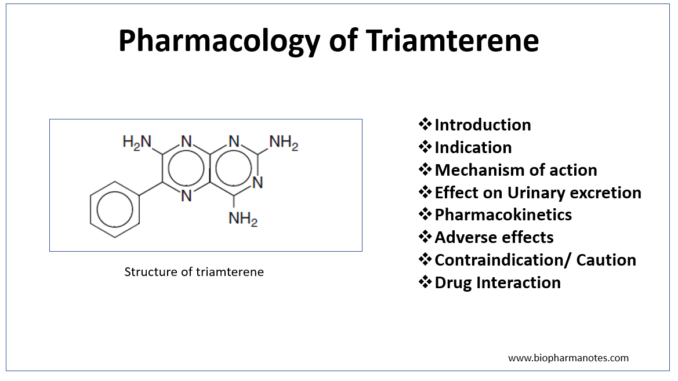
- Triamterene is commonly used potassium sparing diuretics. It is used in medical field since 1964. It is 2nd potassium sparing diuretics to be approved by FDA after spironolactone.
- Potassium sparing diuretics are the agents which inhibit Na+ reabsorption in later part of distal tubule, collecting ducts and inhibit potassium loss by indirect inhibition of K+ and H+.
Indications of triamterene
- It is a weak diuretic and is used in combination with thiazide or loop diuretics to prevent potassium loss caused by these diuretics.
- It is used in pseudo-aldosteronism, a condition characterized by hypertension and hypokalemia but with normal aldosterone secretion.
- For treating edema associated with congestive heart failure, liver cirrhosis, nephrotic syndrome and idiopathic edema.
Mechanism of action of triamterene
- Though spironolactone and triamterene belong to same class, their mechanism of action is different. Its action is indirectly antagonistic to that of aldosterone.
- Triamterene acts specifically on epithelial sodium channels (ENaC) present on luminal side of principal cells in the late distal tubule and collecting duct. ENaC channels are transmembrane channels through which sodium is reabsorbed in exchange for potassium. The sodium reabsorbed from lumen of nephron into collecting tubule is transported out of cell into interstitium via sodium- potassium exchange pump. The collective reabsorption of sodium leads to passive reabsorption of water.
- Triamterene inhibits this ENaC channel, decrease reabsorption of sodium for potassium and hence decrease passive reabsorption of water.
Effects on urinary excretion
- Triamterene causes mild increase in excretion rates of Na+ and Cl– as late distal tubule and collecting duct play limited role in reabsorbing solutes. It has little or no effect on renal hemodynamics.
Pharmacokinetics of triamterene
- Administered orally as monotherapy or in combination therapy. It is metabolized to active metabolite- 4 hydroxy triamterene sulphate. This metabolite is excreted in urine.
- Renal and hepatic patients require dose adjustment.
Adverse effects
- It can cause life threatening hyperkalemia. Other common effects are nausea, vomiting, dizziness, leg cramp, dry mouth, and dehydration.
- Some other serious adverse effects include ventricular arrhythmia, drug induced interstitial nephritis, thrombocytopenia, megaloblastic anemia, hepatotoxicity, and urolithiasis. It may impair glucose tolerance and cause photosensitivity.
Contraindications
- Due to the risk of hyperkalemia, its use is contraindicated in patients having hyperkalemia or in risk of developing hyperkalemia (patients with renal failure, taking other potassium sparing diuretics, taking potassium supplements or patients taking ACE inhibitors).
- It is mostly used in combination with hydrochlorothiazide and this combination is contraindicated in hyperkalemia, pregnancy, severe hepatic or renal impairment, metabolic acidosis and secondary angle closure glaucoma.
Drug Interactions
- The risk of hyperkalemia increases when used in combination with ACE inhibitors, NSAIDs, beta-blockers and ARBs (Angiotensin Receptor Blockers). It increases the plasma level of digoxin.
References
- https://www.ncbi.nlm.nih.gov/books/NBK557650/
- https://go.drugbank.com/drugs/DB00384
- Pharmacology and Pharmacotherapeutics. 24th edition.
- Goodman and Gillman Manual of Pharmacology and Therapeutics.
- Lippincott Illustrated Reviews Pharmacology, 6th edition.
- Essentials of Medical Pharmacology. 7th edition.